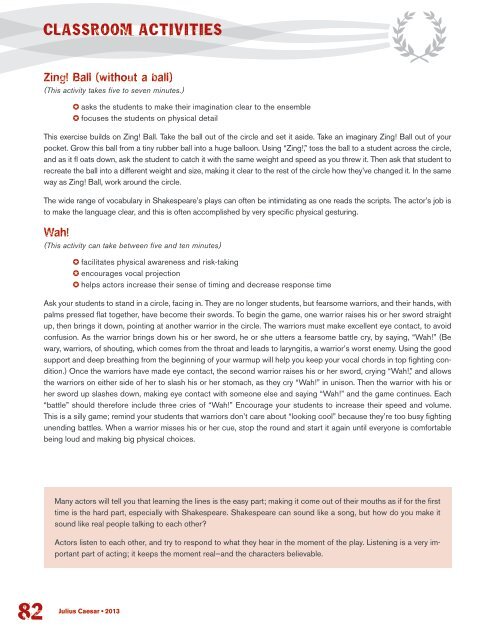Julius Caesar • 2013 - Chicago Shakespeare Theater
Julius Caesar • 2013 - Chicago Shakespeare Theater
Julius Caesar • 2013 - Chicago Shakespeare Theater
Create successful ePaper yourself
Turn your PDF publications into a flip-book with our unique Google optimized e-Paper software.
82<br />
CLASSROOM ACTIVITIES<br />
Zing! Ball (without a ball)<br />
(This activity takes five to seven minutes.)<br />
✪ asks the students to make their imagination clear to the ensemble<br />
✪ focuses the students on physical detail<br />
This exercise builds on Zing! Ball. Take the ball out of the circle and set it aside. Take an imaginary Zing! Ball out of your<br />
pocket. Grow this ball from a tiny rubber ball into a huge balloon. Using “Zing!,” toss the ball to a student across the circle,<br />
and as it fl oats down, ask the student to catch it with the same weight and speed as you threw it. Then ask that student to<br />
recreate the ball into a different weight and size, making it clear to the rest of the circle how they’ve changed it. In the same<br />
way as Zing! Ball, work around the circle.<br />
The wide range of vocabulary in <strong>Shakespeare</strong>’s plays can often be intimidating as one reads the scripts. The actor’s job is<br />
to make the language clear, and this is often accomplished by very specific physical gesturing.<br />
Wah!<br />
(This activity can take between five and ten minutes)<br />
✪ facilitates physical awareness and risk-taking<br />
✪ encourages vocal projection<br />
✪ helps actors increase their sense of timing and decrease response time<br />
Ask your students to stand in a circle, facing in. They are no longer students, but fearsome warriors, and their hands, with<br />
palms pressed flat together, have become their swords. To begin the game, one warrior raises his or her sword straight<br />
up, then brings it down, pointing at another warrior in the circle. The warriors must make excellent eye contact, to avoid<br />
confusion. As the warrior brings down his or her sword, he or she utters a fearsome battle cry, by saying, “Wah!” (Be<br />
wary, warriors, of shouting, which comes from the throat and leads to laryngitis, a warrior’s worst enemy. Using the good<br />
support and deep breathing from the beginning of your warmup will help you keep your vocal chords in top fighting condition.)<br />
Once the warriors have made eye contact, the second warrior raises his or her sword, crying “Wah!,” and allows<br />
the warriors on either side of her to slash his or her stomach, as they cry “Wah!” in unison. Then the warrior with his or<br />
her sword up slashes down, making eye contact with someone else and saying “Wah!” and the game continues. Each<br />
“battle” should therefore include three cries of “Wah!” Encourage your students to increase their speed and volume.<br />
This is a silly game; remind your students that warriors don’t care about “looking cool” because they’re too busy fighting<br />
unending battles. When a warrior misses his or her cue, stop the round and start it again until everyone is comfortable<br />
being loud and making big physical choices.<br />
Many actors will tell you that learning the lines is the easy part; making it come out of their mouths as if for the first<br />
time is the hard part, especially with <strong>Shakespeare</strong>. <strong>Shakespeare</strong> can sound like a song, but how do you make it<br />
sound like real people talking to each other?<br />
Actors listen to each other, and try to respond to what they hear in the moment of the play. Listening is a very important<br />
part of acting; it keeps the moment real—and the characters believable.<br />
<strong>Julius</strong> <strong>Caesar</strong> <strong>•</strong> <strong>2013</strong>




